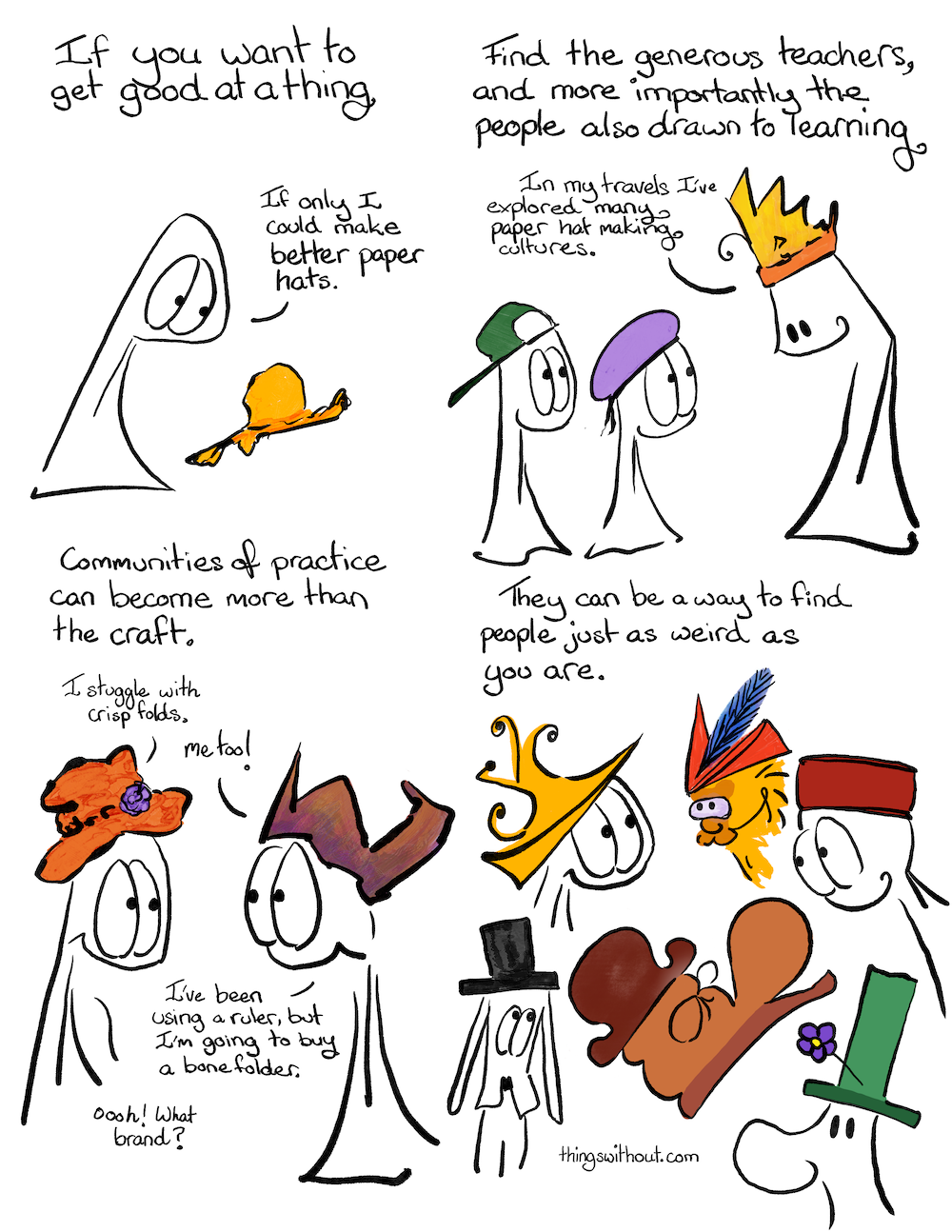Communities of practice
I just finished an interview with Diana Payton for Technical Writing Uncensored and I'm buzzing with the joy of a good conversation. One of the concepts we explored was communities of practice. You form a community of practice around an activity with a shared passion for getting better at doing that thing. What happens is much more than just refining that craft. People who are drawn to a particular kind of activity often have shared traits and can build a community where your own style of weirdness might be more of a norm.

Technical writers often have a wonderful combination of curiously exploring the unknown while organizing the unknown into coherent information and frameworks. When we support and inspire each other to do better and deepen our craft we create joyful communities of practice that go beyond creating portfolio pieces. Finding ways to connect and share ideas with folks on similar frequencies can be so joyful when you might be more of the odd duck in mainstream culture!
It's been heartening this year to see more people stepping back into, or discovering for the first time, the power of blogging on platforms where they have greater control. The communities we can create can be so much more powerful than algorithms in platforms. There is a DIY power that comes from making more decisions about a space that you create and control. I can say welcome to my house, you can welcome me to your house, and they are different houses. It's nice when we can make more with our own hands.
When we create our own houses there can be a challenge of distribution, of being heard, but at least with our own sites we can have RSS feeds and newsletters to know we're reaching the people that have subscribed to listen. We might not be able to escape social media, but we also don't need to live there all the time. We can certainly foster other ways of finding each other.
In that spirit CT Smith has created a webring. You can go there to read more writers in our space.
Kevin R. Kuhl has a nice blog post on what a webring is. He also has a project in the works for publish-on-own-site and syndicate everywhere (POSSE) script for Hugo sites that makes it easier to publish content to some social media platforms. I'm already using the webring to seek out interesting bloggers to listen to. If you want to add yourself to the webring, just make sure you're blogging, not just promoting a portfolio site!
In other news, I had the pleasure and honor of being interviewed by Anurag Shukla in the Docuwiz.io podcast Creating Strategic, Structured and User-centered Docs. To quote their promo:
"Elizabeth Argall seasoned documentation leader who’s helped companies turn messy, ad-hoc content into well-structured, business-driven assets. She shares practical frameworks, proven patterns, and mindset shifts that make documentation more than just a reference; it becomes part of your product strategy.
We explore:
- Why structure matters beyond readability
- How to design docs that scale with teams and products
- Patterns that improve adoption and reduce rework If you care about making documentation a competitive advantage, this one is worth your time."
Media I'm enjoying
- CT Smith's webring
- Kevin R. Kuhl, Tech Writing Webring
- K_R, The P&G Rule of Thirds
- Sid Mier's personal growth rule of thirds no less!
- passo.uno (Fabrizio Ferri Benedetti), Failing Well: A Practical Guide to Growth for Technical Writers
- Is pretty competitive to present at Write the Docs, and Benedetti does not disappoint. Watch the video and he's made his slides available.
- James Tasse, Docs as Tests: Part I — On a High (Level)
- Thanks webring for bringing this blog to my attention!
- Whether you are interested in Docs as Tests or not, I love how he's structured this article. Delicious!
- The Not-boring Tech Writer (Kate Mueller), Kate sounds off on beliefs and maintenance work
- Kate has this wonderful system where she interviews someone and then the next episode she reflects on what was discussed. In a world where there folks feel pressure to crunch out content and keep moving, I love that she has build in this reflective practice. It's also why I like to dig through people's back catalogues when I'm looking for cool media to enjoy :-).
- Liz Argall, Introduction to search term analysis
- I've often said that portfolio sites and blogs should serve the creator, they should be a place you want to go to, even if no one else does! This is definitely the case for me. Because I've taken the time to document intuitive processes and frameworks it makes it easier for me to return to these tools and use them.
- Recently I got a lot of value revisiting this old blog post of mine. It's come in handy when putting together business cases for how technical writers can be proactive in this shifting content landscape. We can move from reactively responding to complaints when a search engine or AI can't find an answer to proactively interrogating our own content.
- And it's handy to have a framework to document quality improvement processes you do innately but might not be visible to stakeholders.
Want to read more blog posts?
Subscribe to my newsletter to be emailed whenever I do an update!
Webring
lizargall.github.io is part of the Tech Writing Blog Webring